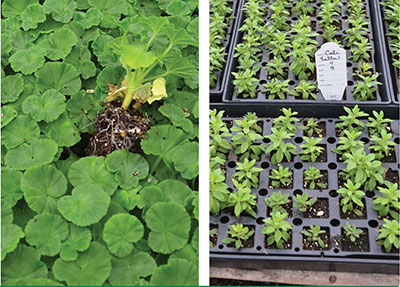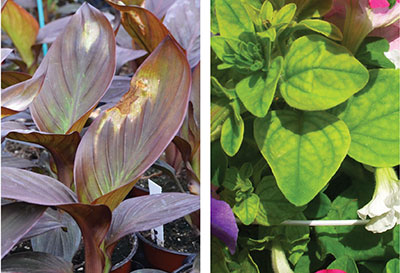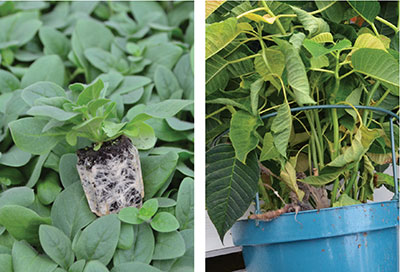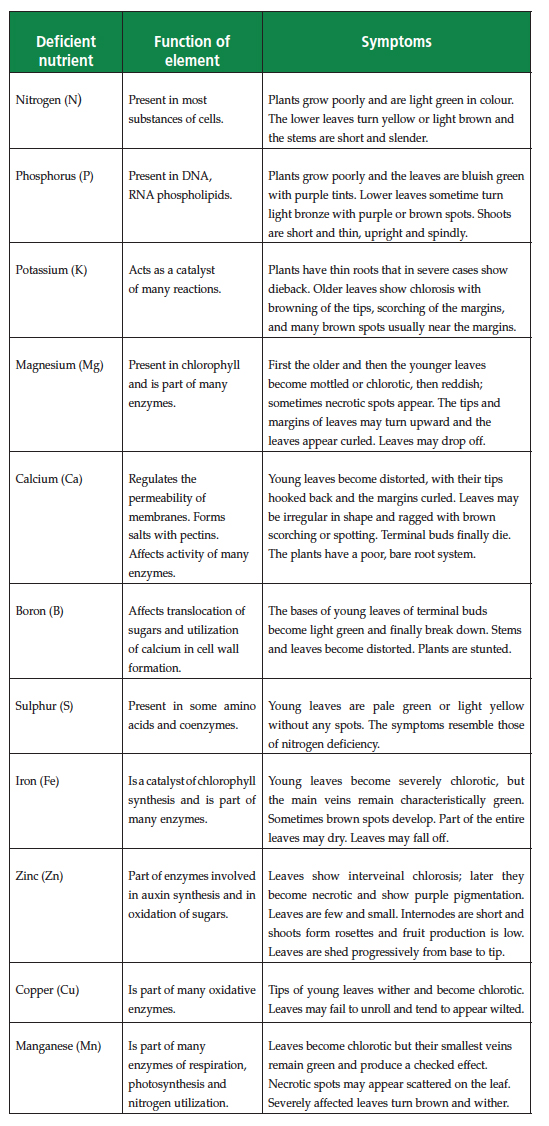
Features
Crop Culture
Inputs
Growing in the Green: Here’s to their health!
December 12, 2013 By Melhem Sawaya
Plants grow best within certain ranges of the various factors that make up their environment.
Plants grow best within certain ranges of the various factors that make up their environment. Included would be temperature, soil moisture, soil nutrients, light, air and soil pollutants, air humidity, soil structure and pH levels.
These factors affect all plants growing in nature.
Plants grown in a greenhouse are in an artificial environment and are subjected to different cultural practices (fertilization, irrigation, spraying with pesticides, etc.) that may affect their growth considerably.
Diseases caused by environmental factors are called non-infectious diseases. They are caused by a lack – or an excess – of something that supports life. If these cases are severe, the plant will die. But if the conditions are only off to a certain limit, then the plant will be weak and diseases will have a better chance to take hold.
Temperature: Plants normally grow at temperatures between 15 and 30 C. Some plants can survive at temperatures as low as 2-4 C and as high as 40 C. However, these extreme temperatures stress a plant’s defensive mechanisms, and its ability to defend itself against disease threats will be compromised.
High temperatures significantly affect plants in conjunction with the effects of other environmental factors, particularly excessive light and drought, lack of oxygen, or high winds accompanied by low relative humidity.
High temperatures are usually responsible for sunscald injuries. These injuries are more prevalent on young, succulent seedlings or on plants when hot, sunny days follow periods of cloudy, rainy weather. When plants are moved from the shaded, cooler propagation area to full hot sun in the finishing house, a transition period is needed by applying light shade to ensure somewhat cooler temperatures.
AVOID THE EXTREMES
The mechanisms by which high and low temperatures injure plants are quite different. High temperatures apparently inactivate certain enzyme systems and accelerate others, thus leading to abnormal biochemical reactions and the death of the cells.
 |
|
| Left: Geranium discoloration via phosphorous deficiency. Right: Lack of general fertilization.
|
Low temperatures, on the other hand, injure plants primarily by inducing ice formation between and/or within the cells.
Moisture: Moisture disturbances are responsible for more plants growing poorly than any other environmental factor. However, low moisture accompanied by high temperatures will lead to an excessive loss of water from the leaves and this will result in leaf scorching or burning.
On the other hand, excessive moisture due to overwatering or poor drainage will cause the fibrous roots of plants to decay due to the reduced supply of oxygen to the roots.
Oxygen deprivation causes stress, asphyxiation and the collapse of many root cells. Wet, anaerobic conditions favour the growth of anaerobic micro-organisms which, during their life processes, form substances such as nitrates that are toxic to plants.
OXYGEN LEVELS
As well, root cells damaged directly by a lack of oxygen lose their selective permeability and may allow toxic metals, etc., to be taken up by the plant. Also, once parts of roots are killed, more damage is done by facultative parasites that may be greatly favoured by the new environment.
Thus, the wilting of the plants, which soon follows overwatering, is probably the result of a lack of water in the above-soil parts of plants caused by the death of their roots. It appears that translocated toxic substances may also be involved.
Another common symptom of plants that is caused by excessive moisture is the so-called edema. This appears as numerous small bumps on the lower side of leaves or on stems.
The bumps are small masses of cells that divide, expand and break out of the normal leaf surface and at first form greenish white welling or galls.
Later, the exposed surface of the swelling becomes rusty coloured and has a corky appearance.
Edema is caused by overwatering and can be avoided by reduced watering, along with improved lighting and air circulation.
Inadequate oxygen levels: Low oxygen conditions are generally associated with high soil moisture and/or high temperatures. Lack of oxygen will destroy roots if they are waterlogged for long periods.
AVOIDING ROOT COLLAPSE
A combination of high soil moisture and high soil or air temperature causes root collapse in plants. The first condition apparently reduces the amount of oxygen available to the roots, while the other increases the amount of oxygen required by the plants. The two effects together result in an extreme lack of oxygen to the roots and cause their collapse and death.
 |
|
| Left: Lack of light effects, but otherwise perfectly healthy plants. Right: Uneven unrooted cuttings leading to oversaturated stunted cuttings.
|
Light: Lack of sufficient light retards chlorophyll formation and promotes slender growth with long internodes, leading to spindly pale-green leaves and a premature drop of leaves and flowers.
Excessive light is rather rare in nature and seldom injures plants. Many injuries attributed to light are probably the result of high temperatures accompanying high light intensity.
Air pollution: The air at the earth’s surface consists primarily of nitrogen and oxygen (78 per cent and 21 per cent, respectively), with much of the remaining one per cent being water vapour and carbon dioxide.
The result of the industrial revolution and man’s activities in generating energy, manufacturing goods and disposing of wastes is the release into the atmosphere of a number of pollutants that may alter a plant’s metabolism and induce disease.
PROBLEMS WITH POLLUTION
Almost all air pollutants causing plant injury are gases, but some particle matter or dust may also affect vegetation. Ethylene is a known pollutant caused by lack of heater ventilation. The plant itself can produce ethylene under high moisture conditions. It can also be caused by leaks in cooling systems (ammonia).
 |
|
| Left: Salt injury from fertilizer on the leaves, which cannas do not tolerate. Right: Yellowing on petunia due to a lack of fertilizer.
|
Damage is more commonly caused by chemicals such as hydrogen fluoride, nitrogen dioxide, ozone peroxyacyl, sulphur dioxide and particulates. High concentrations or long exposure to these chemicals causes visible and sometimes characteristic symptoms (e.g., necrosis) on affected plants. A good example of this is the needlepoint spots on old poinsettia leaves due to nitric oxide and ozone.
Exhaust from automobiles and other internal combustion engines are probably the most important sources of ozone and other phototoxic pollutants.
Thousands of tons of incompletely burned hydrocarbons and NO2 are released into the atmosphere daily by automobile exhausts. In the presence of ultraviolet light from the sun, this nitrogen dioxide reacts with oxygen and forms ozone and nitric oxide. The ozone may react with nitric oxide to form the original compounds:
NO2 + O2 O3 + NO
However, in the presence of unburned hydrocarbon radicals, the nitric oxide reacts with these instead of ozone, and therefore the ozone concentration builds up. Ozone, too, can react with vapours of certain unsaturated hydrocarbons, but the products of such reactions (various organic peroxides) are also toxic to plants.
Because of this, greenhouses near heavily populated areas and lots of traffic are not in the best location!
 |
|
| Left: Looking good: a healthy plug. Right: Phytophthora stem rot leading to botrytis.
|
Plants require several mineral elements for normal growth. Some elements, such as nitrogen, phosphorus, potassium, calcium, magnesium and sulphur needed in relatively large amounts are called major elements, while others – such as iron, boron, manganese, zinc, copper and molybdenum – are needed in very small amounts and are called trace or minor elements, or “micro-nutrients.”
Both major and trace elements are essential to the plant. When they are present in amounts smaller than the minimum levels required for normal growth, the plant becomes diseased and exhibits various external and internal symptoms. Theses symptoms may appear on any or all organs of the plant, including leaves, stems, roots, flowers and seeds.
The kinds of symptoms produced by a deficiency of a certain nutrient depend primarily on the functions of that particular element in the plant.
These functions presumably are inhibited or interfered with when the element is limited. Certain symptoms are the same if there is a deficiency of any of several elements, but other diagnostic features usually accompany a deficiency of a particular element.
Numerous plant diseases occur annually in most horticultural crops in many locations due to reduced amounts or reduced availability of one or more essential elements in the media in which the plants are grown.
The table in this feature lists some of the general deficiency symptoms caused by each essential element. The soil often contains excessive amounts of certain essential or non-essential elements, any of which at high concentration may be injurious to the plant.
Of the essential elements, those required by plants in large amounts, such as nitrogen and potassium, are usually much less toxic when present in excess than are the elements required only in trace amounts, such as manganese, zinc and boron.
Even among the latter, however, some trace elements such as manganese and magnesium have a much wider range of safety than do others, such as boron or zinc.
Concentrations at which non-essential elements are toxic also vary among elements, and plants in turn vary in their sensitivity to them. For example, some plants are injured by very small amounts of nickel, but can tolerate considerable concentrations of aluminum.
The injury occurring from an excess of an element may be slight or severe and is usually the result of direct injury by the element to the cell.
On the other hand, the element may interfere with the absorption or function of another element and thereby leads to the symptoms of a deficiency of the element being interfered with. Excessive sodium, as an example, induces a deficiency of calcium in the plant, while the toxicity of copper, manganese or zinc is both direct on the plant and induces a deficiency of iron in the plant.
Starting with healthy plants in a healthy environment is the best treatment you can have, economical, and the best natural biological control you can apply. All what it takes is implementing common sense at the right time!

|
|
Melhem Sawaya of Focus Greenhouse Management is a consultant and research coordinator to the horticultural industry. Comments on this or any other article are welcome at mel@focusgreenhousemanagement.com, or by visiting.
Print this page